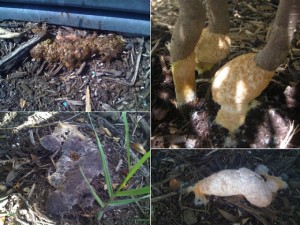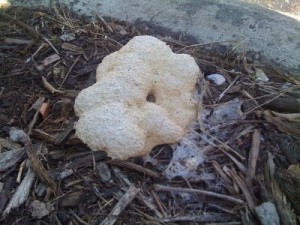This week’s blog was written by guest blogger Dustin H. Purcell, MS. Dustin is a Mycologist/Plant Pathologist who studied at the University of Florida.
It isn’t truly a fungus, but it’s fungus-like enough that mycologists (scientists who study mushrooms and other fungi) study it. Technically it is a Myxomycete, or plasmodial slime mold, named Fuligo septica. It looks kind of like that expanding foam used to fill cracks and gaps in walls around the house and garage. It has no definite shape, just a small irregular mound less than an inch in height and anywhere from around an inch to over a foot in diameter (if an irregular shape is allowed to have a diameter). Unlike expanding foam, it has a crusty-flaky coating instead of a smooth firm “skin”. If you scrape the yellowish-tan coating away (you can use your finger, but a stick will work if the that sounds too gross), you’ll see the purplish-brown spore mass inside. Spores are like seeds… They are the way myxomycetes reproduce and spread from place to place. When mature, it is completely dry and will disintegrate into an airborne cloud of spores under foot or lawnmower. Before it matures, it looks like a slimy-gooey-frothy yellowish-brownish-greenish blob.

The dog vomit “fungus” (Fuligo septica) in its natural habitat… your yard. The specimen at the upper left is not yet mature. It is still a gooey blob that will probably dry into a crusty-powdery mass by the end of the day. On the upper right is a collection of three mature myxomycetes that have migrated up plant stems in order to produce spores. This will not harm the plant! Wind, rain and sprinklers will wash it away. The photo below this shows an individual about 5 inches long sitting on the mulch of a garden bed. On the lower left is a large specimen (over a foot long!) following a good rain that washed away the yellow crusty coating to expose its purple-black spores.
They are common following rains or irrigation during the warmer months anywhere there is ample organic matter. This includes lawns, mulched areas, compost piles, bare soil, tree stumps and old logs. Sometimes they even “climb” a few inches up walls or the base of plants. They are not known to be harmful at all to plants or animals (including humans). Before coming to the soil surface to scare and gross out humans, they migrate through the soil as large amoebae (called plasmodia) ingesting tiny bits of decaying debris, bacteria and other microorganisms. They are not associated with any plant disease. Rather, they are an important component of the soil ecosystem and indicate that there is a decent amount of moisture and organic matter in the soil. This is a good thing, because landscape plants normally do well in soil with ample moisture and organic matter. Undisturbed, they can last for weeks in the yard until a good rain washes the spores back into the soil. Animals, including curious children armed with sticks and lawn men with lawnmowers, will also hasten the weathering process by scattering their spores to the wind.
So try not to be repulsed the next time you spot these unsightly creatures in your yard. They are probably helping your landscape, and at the very least they are doing no harm.
 3
3

